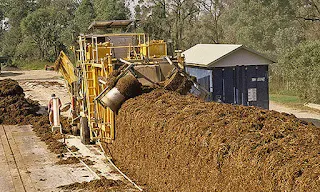The substrate on which button mushroom grows is mainly prepared from a mixture of plant wastes (cereal straw/ sugarcane bagasse etc.), salts (urea , superphosphate / gypsum etc), supplements (rice bran/ wheat bran) and water.
In order to produce 1 kg.of mushroom, 220 g. of dry substrate materials are required. It is recommended that each ton of compost should contain 6.6 kg. nitrogen, 2.0 kg. phosphate and 5.0 kg. of potassium (N:P:K- 33: 10:25) which would get converted into 1.98% N, 0.62% P and 1.5% K on a dry weight basis.
The ratio of C: N in a good substrate
should be 25-30 : 1 at the time of staking and 16-17 : 1 in the case of final
compost.
(A) Short Method of composting
During the first phase of compost preparation, paddy straw is placed in layers and sufficient water is added to the stack along with fertilizers, wheat bran, molasses etc.
The whole thing is mixed thoroughly with the straw and made into a stack (almost 5feet high,5 feet wide and of any length can be made with the help of wooden boards).
The stack is turned and again watered on the second day. On the fourth day the stack is again turned for the second time by adding gypsum and watered.
The
third and final turning is given on the twelveth day when the colour of the
compost changes into dark brown and it starts emitting a strong smell of
ammonia.
The second phase is the pasteurization phase .
The compost prepared as a result of microbe mediated fermentation process needs to be pasteurized in order to kill undesirable microbes and competitors and to convert ammonia into microbial protein.
The whole process is carried out inside a steaming room where an air temperature of 600 C is maintained for 4 hours.
The compost finally obtained should be granular in structure with 70% moisture content and pH 7.5.
It should have a dark brown colour, sweet unobnoxious smell and free from ammonia, insects and nematodes.
After the process is complete, the substrate is cooled
down to 250 C.
(B) Long Method of composting
The long method of composting is usually practiced in areas where facilities for steam pasteurization is not available.
In this method, the first turning is given about six days after preparation of the substrate for composting.
The second turning is given on the tenth day followed by third one on the thirteenth day when gypsum is added.
The fourth, fifth and sixth turnings are given on the sixteenth, nineteenth and twenty-second day.
On the twenty-fifth day the seventh turning is given by adding 10% BHC (125 g.) and the eighth turning is given on the twenty-eighth day after which it is checked whether there is any smell of ammonia present in the compost.
The compost is ready for spawning only
if it doesn’t have any smell of ammonia; otherwise a few more turnings are
given at an interval of three days till there is no smell of ammonia.









0 Comments